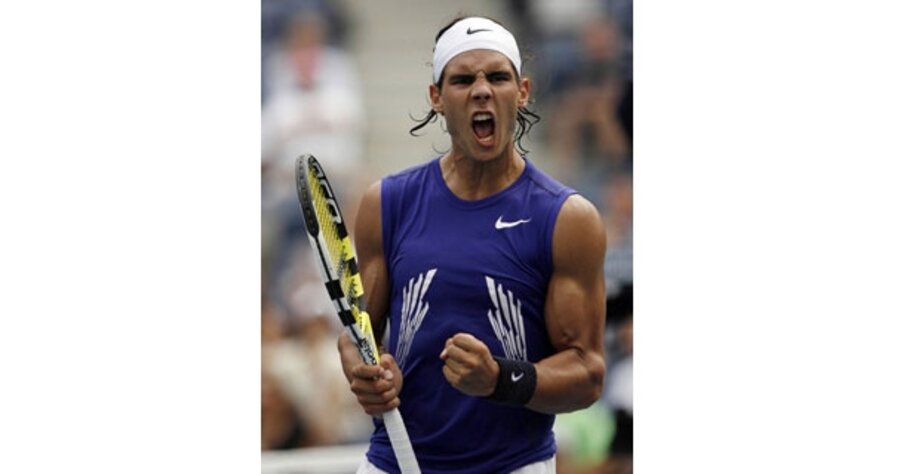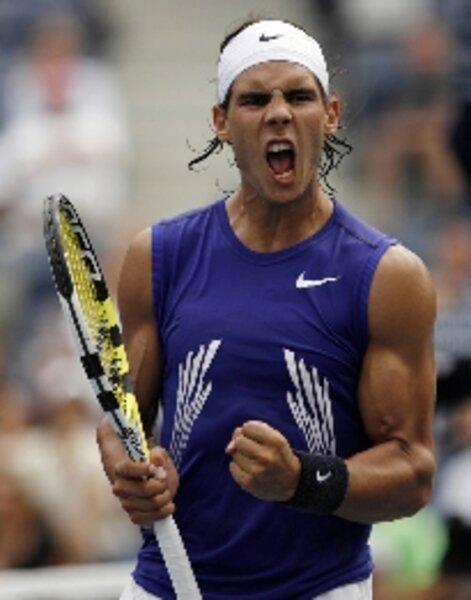Rafael Nadal moves relentlessly toward dethroning tennis’s reigning king
Loading...
| New York
As rivals, they form a perfect tennis tableau: There’s the great Roger Federer, for 4-1/2 years touted as, inevitably, the greatest ever, he of the elegant V-neck sweaters, Rolex watches, and classic, near-perfectly graceful game.
But here’s Rafael Nadal, who spent a record 160 weeks as the second-best player, his swarthy, spider-veined biceps flailing about his sleeveless T’s and knee-length koulats, his mane of sweaty hair whipping over every grunt-propelled forehand as he pursued the Swiss genius. In July, finally, after a sodden five-set epic match in Wimbledon’s gloaming, Rafa all but ended Roger’s record reign as the No. 1 player in men’s tennis.
And while fans are clamoring for a third straight Grand Slam final featuring these two here at the US Open, the tennis world has been buzzing the last two months about the rise of Nadal, who also crushed Federer at this year’s French Open and won the gold medal in Beijing.
See, three months ago, Federer was tennis’s version of Tiger Woods, Wayne Gretzky, or Michael Jordan. Now, some wonder whether he can handle a year of such devastating defeats, when history was just within his grasp. Suddenly, there’s a story line.
“That Wimbledon final either brought fans out of dormancy or made new fans for the game,” says long-time tennis analyst Bud Collins. “I know I hear people talking about it, who first saw it on television, and I think it enlivened the sport tremendously, especially here at the US Open, where everyone wants to see them thrown together again. When you’re 4-1/2 years on top of the world, everybody’s looking for you to fall off. And now he’s fallen off, and it makes for great drama.”
•••
It’s a drama that many feel has been lacking in the men’s game for the past decade, especially since the golden era of the 1970s and early 1980s, when tennis was almost as popular as baseball and football. John McEnroe and Jimmy Connors, who despised each other, threw regular tantrums on the court; Björn Borg dominated Wimbledon and Roland Garros; and even tennis chic defined a certain sense of style at roller rinks and discos.
Many compare this year’s Wimbledon final with the era-defining finals back then. In 1980, Borg won his fifth straight Wimbledon title, defeating first-time finalist McEnroe in an epic match long considered the greatest ever played – until this year’s. In 1981, McEnroe finally defeated Borg, ending both his record streak and dominance. After that defeat, Borg never won a Wimbledon title again, and McEnroe began his own run as the No. 1 player in the world.
Of course, unlike McEnroe, Nadal had already won four straight French Open titles, including three straight over Federer. But there have been other Spanish clay-court masters – a surface that has stymied greats like Connors, McEnroe, Becker, and Sampras, none of whom could ever win there – and Rafa was simply the best of them. And while he had pressed Federer in a thrilling five-set final at Wimbledon in 2007, most tennis observers believed Federer would continue to add to his 12 Grand Slam trophies on surfaces other than clay and win his sixth straight.
“What we’ve seen is that fans really weren’t embracing Rafa up until, really, this year, when he overtook Federer in that Wimbledon final,” says James Martin, editor of Tennis Magazine and Tennis.com. “It solidified Rafa as a fan favorite, and not just another clay-court specialist.”
But perhaps even more than the bruising, relentless style of the tennis he plays, Nadal brings a new kind of personality to the sport, which has been without the colorful personalities that once drew myriads of fans.
But unlike a Connors or a McEnroe, Nadal is quiet and demure, and has been very respectful – some say too respectful – of Federer. “He’s a good kid, and he’s like a big puppy and is very appealing to people, perhaps more than Federer,” says Mr. Collins, the tennis analyst.
“Without actually being all that more verbal than Roger, he has a sort of je ne sais quoi charm to him,” says Toby Miller, professor of media and cultural studies at the University of California, Riverside, and an expert on the impact of sports on culture. “Nadal is more of a brooding sex symbol, and I’m sure he’ll have his own band of new young female fans.” The back cover of last month’s fashion issue of New York Magazine featured a shirtless Nadal in jeans.
Indeed, Nadal already seems to have achieved a pop status that the more understated Federer never had. “He’s not just about tennis now,” says Mr. Martin. “After that final, you started seeing Nadal in the tabloid magazines with his girlfriend on the beach in Majorca. He’s mentioned on the late-night talk shows, and he’s became a pop culture person in a way very different than Roger has.”
Even while Federer shills chichi watches and Gillette razors, few clamor for dirty details of his private life, usually just speaking in reverent tones about his graceful tennis game. Nadal’s appeal lies in his intensity and ferocity on the court.
“He isn’t fluid. He doesn’t make it look easy like Roger has for the last four or five years, so it’s one of those things where people have really fallen in love with him as a player because they can see how hard he works to win every point and how he treats every point equally, which really no other player does,” says Martin.
This maniacal intensity, however, leaves some wondering how long he can keep it up. “The big worry about Nadal is, how long will he hold up playing this overpowering style?” says Collins.
•••
This week, the tennis world will be anxiously watching whether Nadal will follow up on his dramatic success this summer or whether Federer will be able to overcome the mental challenges of losing the No. 1 ranking for the first time in nearly half a decade.
Nadal has never made it past the quarterfinals at the US Open or Australian Open, which are played on hard courts – not a surface he has excelled in. And other players, such as third-seeded Novak Djokovic, who will be looking to follow up on his victory over Federer in this year’s Australian Open, and past US Open champ Andy Roddick, could easily win the tournament as well.
But the major story line in tennis now is the transformed rivalry between Federer and Nadal. “If Rafa wins the US Open, it will really, really put incredible pressure on Roger,” says David Egdes, senior vice president of the Tennis Channel. “Is Nadal going to dominate the same way that Roger did, or will Roger respond and raise the level of his game? It’s a big question mark.”






